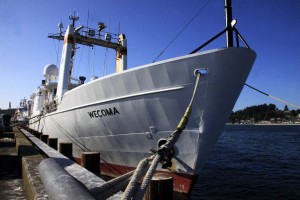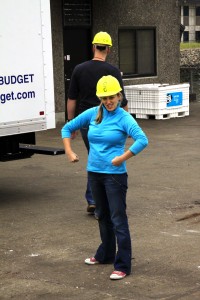We have a number of people with photographic expertise aboard ship. Here is a sample of the wonderful photos we have of cruise life. (Captions by Amy Maas)
Before setting off from the dock we have to hook up all of our equipment to the winches and make sure everything is safely lashed down on the back deck. This is a huge project which took up most of September 17th.
This is the multicore – a tool that lets us sample the bottom (benthos) for biological, chemical and geological information. The spider looking device is lowered to the bottom and then deploys the pvc tubes into the muddy bottom. They seal up using a vacuum top and are brought to the surface.
Researcher Craig McClain setting up the multicore. Those plastic tubes bring our samples up to the surface.
Amy Maas estimating the wire angle on a net deployment. If we don’t have a pressure (depth) sensor on our equipment the only way we can estimate the depth we are sampling for animals is to use basic trigonometry. We know how much wire we send out and using this tool, called an inclinometer, we can estimate the angle. With that information we have a good idea of how deep the net was.
These are our very patient and wise marine techs. They serve as technical advisors, help us deploy our equipment and assist us in fixing everything we break. Think MacGyver.
Part of going out to sea is understanding the risks of working from an oceanic platform. Before leaving port we had a fire drill and and abandon ship drill. This let us know where we should muster if anything went wrong. In this photo Craig McClain is modeling the survival gear that we would put on in event of abandoning ship.
Our Marine techs are setting up the multicore at sunset.
Heather Beem soldering circuit components onto her experimental flow sensor.
It is always important to take a moment to revel in the beauties of shipboard life.
Jennifer McKay sampling the CTD for Winkler titrations. This analysis measures the concentration of dissolved oxygen in the water.
A photo of Laurel Childress modeling the gloves of the survival suits.
Deployment of the multicore at sunrise
Once the multicore is onboard the pvc tubes full of bottom mud are taken aside. The mud is extruded (pushed up out of the tube) in a controlled manner letting the scientists take discrete depth subsamples.
The multicore coming up out of the water.
Deploying the large Tucker trawl off of the back deck at night. This is our most personnel intensive event requiring a marine tech, 5 scientists and a winch operator. The animals we bring up from depth are well worth the effort though!
Clare Reimers, organizer of this cruise watching deck operations unfold.
Our floating research lab and home for September 18th – 25th.
Meghan Powers in her fashionable safety gear getting ready for a deployment of the Tucker trawl. The general rules are that any time you send something overboard a work vest is required. Any time you are working with overhead lines or blocks you must have a hard hat. Closed toed shoes, preferably steel-toed, are required for all deck operations.
The multicore at sunset. Running a complicated piece of gear like this is an art form, so technician Chris Moser is passing on his expertise to the coring crew.
The Tucker trawl is special in that we can control the opening and closing of the net by sending down weights (called messengers) along the cable. These messengers run into a specially machined piece called a double trip (the piece at the top of the photo). When the first messenger comes down the line it causes the double trip to drop the bottom bar which opens the net and starts our sampling. When the second messenger hits the double trip it drops the top bar which closes the net. This allows us to collect animals from only the depths that we want. This picture shows Karen Osborn setting up the double trip by stretching the bridles (lines) to the appropriate height to let the bars hang perfectly.
Since this research cruise is a number of projects all cobbled together, many of us are relying on the kindness of others to let us do our sampling. The Tucker nets for this expedition, in which we collect all the surface and midwater animals, were lent to us by researchers at the Monterey Bay Aquarium Research Institute (MBARI). Meghan Powers and Henk-Jan Hoving drove them up in a U-Haul on September 15th.



























